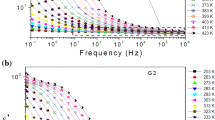Abstract
That ionic conductivity in glass is a non-exponential process and has been known for many years. The amorphous structure of glass and hence a distribution of cation sites has often been thought to be the cause for the non-exponentiality. Almost completely unresearched, however, has been the effect of glass composition on the nature of the relaxation process. In this paper, we review the observations that have been made of the relationships between glass composition and the non-exponential character of the conductivity relaxation as well combine our recent wide composition range studies of sodium aluminoborate and lithium phosphate glasses to delineate the major features of the correlation. By examining glass compositions ranging from 0.02 to 60 mole% alkalioxide, it is observed that the rapid development of non-exponentiality within 1% Na2O is accompanied by a similar rapid decrease in the average cation-cation separation distance, this being calculated using the composition and density. Other quantities such as the dc conductivity or activation energy are observed to vary too slowly with composition to produce a linear correlation with the extent of non-exponentiality as monitored in theβ parameter of the stretched exponentialkww function.
Similar content being viewed by others
References
A. Pradel, M. Ribes: Materials Chemistry and Physics (in press)
C.A. Angell: Solid State Ionics18/19, 72 (1985)
H.L. Tuller, D.P. Button, D.R. Uhlmann: J. Non Cryst. Solids40, 93 (1983)
M.D. Ingram: Phys. Chem. Glasses28, 215 (1987)
R.J. Grant, M.D. Ingram, L.D.S. Turner, C.A. Vincent: J. Phys. Chem.82, 2838 (1978)
J. Wong, C.A. Angell:Glass: Structure by Spectroscopy (Dekker, New York 1976) Chap. 11
D.P. Almond, G.K. Duncan, A.R. West: J. Non-Cryst. Solids74, 285 (1985)
P.B. Macedo, C.T. Moynihan, R. Bose: Phys. Chem. Glasses13, 171 (1972)
C.T. Moynihan, L.P. Boesch, N.L. Laberge: Phys. Chem. Glasses14, 122 (1986)
S.W. Martin, C.A. Angell: J. Non-Cryst. Solids83, 185 (1986)
K.L. Ngai, J.N. Mundy, H. Jain, O. Kanert, G. Balzer-Jollenbeck: To be published
G. Williams, D.C. Watts: Trans. Faraday Soc.66, 80 (1970)
G. Williams, D.C. Watts, S.B. Dev, A.M. North: Trans. Faraday Soc.67, 1323 (1971)
G. Williams, P.J. Hains: Faraday Symp. Chem. Soc.6, 14 (1972)
K.L. Ngai: Solid State Ionics5, 27 (1981)
S.W. Martin, C.A. Angell: J. Non-Cryst. Solids66, 429 (1984)
S.W. Martin, C.A. Angell: J. Am. Ceram. Soc.67, C-148 (1984)
S.W. Martin, H. Patel: To be published
C.A. Angell, S.W. Martin: Mater. Res. Bull. (submitted)
S.W. Martin: Solid State Ionics18/19, 472 (1985)
S.W. Martin: J. Am. Ceram. Soc.71, 438 (1988)
See for example, K. Ngai: Solid State Ionics5, 27 (1981)
P.B. Elterman, C.J. Simmons, J.H. Simmons: J. Am. Ceram. Soc.62, 158 (1979)
P. Debye:Polar Molecules (Chemical Catalogue Co., New York 1929)
J. Zhong, P.J. Bray: In Proceedings of International Conference on the Physics and Chemistry of Glasses, N.Y. Alfred, 1985, J. Non-Cryst. Solids84, 17 (1986)
V. Provenzano, L.P. Boesch, V. Volterra, C.T. Moynihan, P.B. Macedo: J. Am. Ceramic Soc.55, 492 (1972)
K.L. Ngai, R.W. Rendel, H. Jain: Phys. Rev. B30, 2133 (1984)
S.W. Martin, D. Torgesen: To be published
G.W. Morey, H.E. Merwin: J. Opt. Soc. Am.22, 632 (1932)
F. Winks, W.E.S. Turner: J. Soc. Glass Tech.15, 58 (1931)
A.M. Efimov, E.K. Mazurina, V.A. Kharyuzov, M.V. Prodskuryakov: Fiz. Khim. Stekla2, 151 (1976)
J. Sakka, K. Kamiya: Non-Cryst. Solids49, 103 (1982)
E.F. Gooding, W.E.S. Turner: J. Soc. Glass Tech.18, 32 (1934)
M. Foex: C. R. Acad. Sci.208, 278 (1939)
A. Karki, S. Feller, H.P. Lim, J. Stark, C. Sanchez, M. Shibata: J. Non-Cryst. Solids92, 11 (1987)




